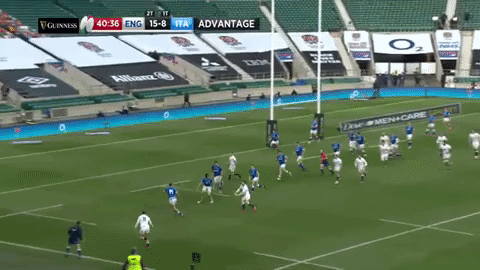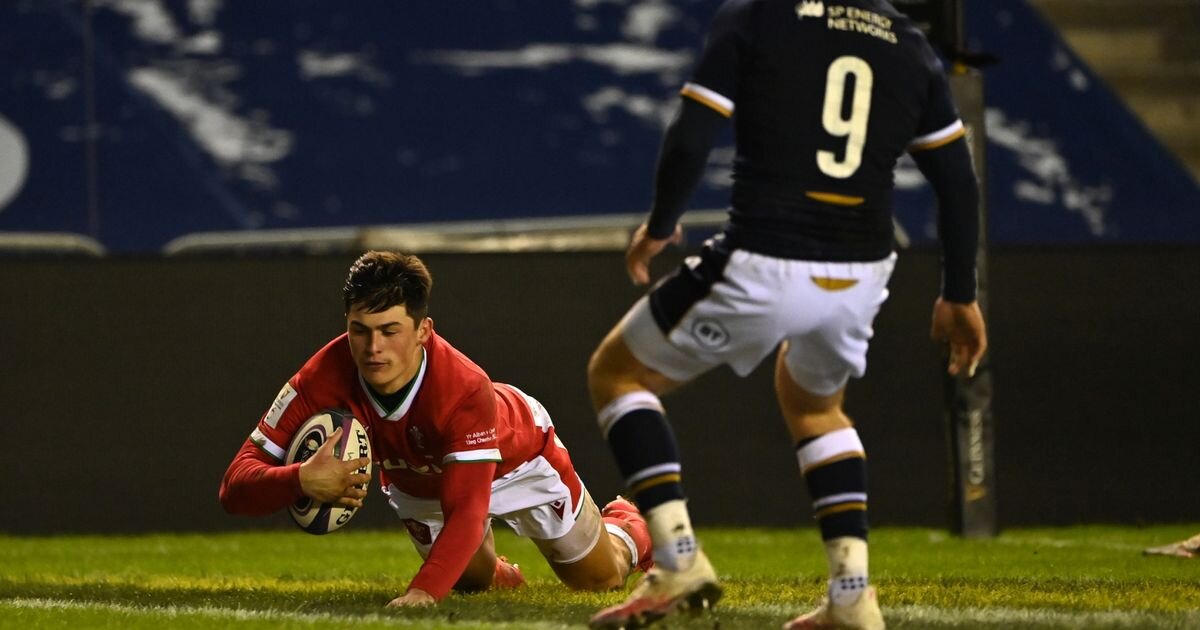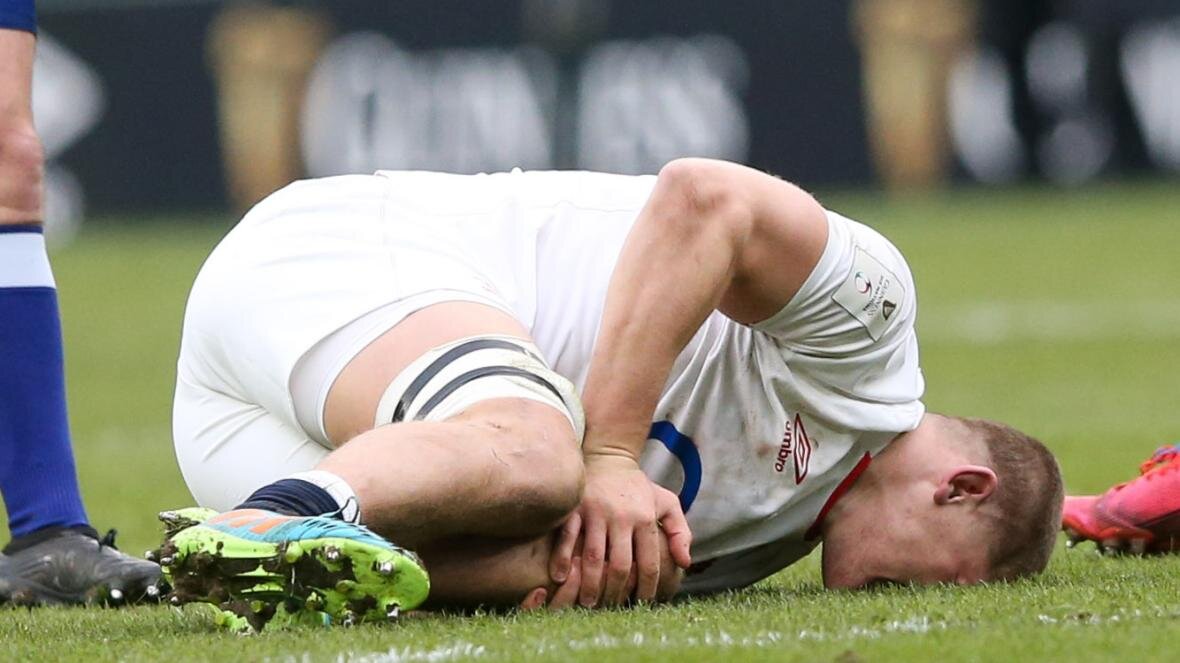Six Nations 2021: Six Talking Points from Round 2
Zander Fagerson looks perplexed at his red card during Scotland’s 25-24 loss to Wales
Credit: Reuters
It was Napoleon Bonaparte who once said: “Never interfere with your enemy when he is making a mistake.”
Wales seem to have taken this mantra on board in their Six Nations campaign as they benefitted from a contentious red card following Peter O’Mahony’s dismissal last time out.
Whereas O’Mahony’s red was fairly clearcut, Zander Fagerson and Scotland can feel hard done by theirs on the way to a narrow 25-24 loss at Murrayfield.
On Saturday lunchtime, England got back to winning ways after they saw off plucky Italy 41-18 thanks in no small part to a wonderful finish from a flying Jonny May.
Fast forward to Sunday afternoon and Dublin saw Franch squeeze past a determined Ireland 15-13. Les Bleus will feel they should have been out of sight earlier in the contest but saw the job through to top the embryonic table with Wales.
As the tournament takes a break for a week, here are the key takeaways from Round 2.
The ruck now a militarised zone as Fagerson falls foul of modern interpretation
Let’s unpick it in that order. Even the most ardent Wales fan will admit they were again below par but as the old saying goes: a win is a win is a win.
Wales roared back from a 17-3 half time deficit to claim the 25-24 victory. Much like a Mourinho team, they again sat back, absorbed pressure and relied upon individual stardust to inspire them to a win. In this case, a wonderful brace from young winger Louis Rees-Zammit.
They were restricted to a measly 188 running metres, 35% territory and 38% possession but still walked away with the points. Credit to them, they now sit top of the table and, ultimately, got the job done despite the odds, ultimately, stacked in their favour.
Onto the red now. For those who didn’t see it, Scotland prop Zander Fagerson was overzealous heading into the ruck and catches opposite number Wyn Jones with a shoulder in the chin/neck area.
However, the point of contact is hard to determine given Jones is jackalling over the ball but referee Matthew Carley was adamant it was to the head.
Despite being advised by TMO Karl Dickson that a yellow was probably sufficient, referee Carley issued a red on the 54-minute mark.
Of course, The Flanker is fully in favour of player safety and that is paramount. However, it is a physical game played by enormous men and so-called “rugby incidents” happen which, when shown back on slow-mo, are then analysed to the nth degree.
The above was a rugby incident that, at best, was a yellow offence and if we are to continue with these types of challenges being red card then there will be dismissals every game.
Yes, Fagerson comes from a fair way away but it was not out of control, reckless or even having that much force behind it. It is not feasible, from an onlooker, how Fagerson is supposed to contest for the ball without doing what he did given Jones’ head is so low to the floor.
If they are now red cards, players may as well just let the jackaller get their head into position before even attempting a clearout for fear of being punished. Quite often, it can boil down to interpretation or how it looks when watched back from multiple angles.
Referees are now crippled by the World Rugby framework that allows no interpretation or common sense allowed to come into it. You make contact with the head, its a red - no excuses.
Much like in football, where the handball law interpretation became utterly ridiculous until the Premier League were forced to step in, the contests at the ruck could become less and less frequent if the punishments remain this extreme.
Despite this, Scotland nearly pinched the win only for Price to elect to kick away possession in the 79th minute when they were camped in Wales’ half.
Like Billy Burns a week earlier, it was a rush of blood to the head from Price when the sensible option was to retain possession and look to force a penalty by grinding down the red defensive wall.
You can’t fault the endeavour but in the cauldron of a test match, tight margins decide results. Price, who had another fine game, should remember his decision but not dwell on it too much.
England professional in victory as Jonny May takes to the skies
Back in March 1983, when Scotland last beat England at Twickenham in the Five/Six Nations, Billie Jean by Michael Jackson was top of the charts and current Head Coach Gregor Townsend was just nine years old.
Following on from last weekends historic 11-6 gubbing from the Auld Enemy which updated the above record, England needed a reaction in both result and performance.
For the most part, that got exactly that in their 41-18 victory over a depleted and youthful Italy - gaining some much-needed confidence and actually looking to work the ball through the hands at most given opportunities.
Before the naysayers argue “so what?” this was still a test match that required a professional performance and that is exactly what was served up.
Elliot Daly, despite missing two crucial tackles as questions linger over his defensive game at fullback, and Henry Slade both impressed with the ball in hand - making over 120 metres between them.
Anthony Watson bagged a delightful brace, one of which a 70m interception run-in, with the Bath man carrying for 138 metres and was explosive on his continued return from long term injuries.
However, he was overshadowed by a moment of pure brilliance from Jonny May on the opposite wing.
Receiving the ball deep into the Italian 22, he has a small corridor of space to work in before the blue shirts come swarming across.
Tiptoeing the white line, he quickly realises he has to get airborne if he is to avoid covering winger Luca Sperandio from knocking him into touch.
He does this with aplomb, flicking his legs over the touchline in the air before just managing to get the ball down in time before his feet do - leaving Sperandio wondering what the hell happened and grasping fresh air.
It was a world-class finish from a man who could beat his opposite man in a phone box and adds further evidence to the fact that May is the archetypal finisher.
Even the most ardent members of the “Owen Farrell is a fly-half” fan club must be starting to question their entire foundations after such an insipid display against Scotland last week.
Restored back at inside centre, with his trusted lieutenant George Ford inside him, he managed to exude his usual quiet influence over proceedings.
Head Coach Eddie Jones and even Farrell, deep down, must now accept his game benefits from a primary playmaker next to him in the 10 shirt.
Although Jacob Umaga and Marcus Smith, both starring in the Premiership for Wasps and Harlequins respectively, will surely earn England honours in the future - Ford had an excellent game after his promotion back into the team.
The Leicester man completed 40 passes in the game, four times as many as opposite fly-half Paolo Garbisi for context, as he looked to exploit the front foot ball his pack provided for him.
For the forthcoming trip to Cardiff in two weeks time against the table toppers, if England are to exploit a rather fragile Wales defence, this tried and trusted 10/12 axis has to remain in place.
The era of the 14-man death knell is over
Rugby traditionalists will tell you there was a time even as recently as ten years ago when a red card was unheard of in Test rugby, and a yellow card was the harbinger of a death knell to any team.
Any team that went down to 14 men was up against it and often the opposition would take the game away from a depleted adversary over the course of those minutes, even if the game had to that point been finely balanced.
These days, however, losing a man is not nearly the issue it once was and teams have discovered ways to tactically adapt
We first saw evidence that losing men from the field was not the obstacle it might once have been in 2015 when Australia and Wales faced off in the World Cup.
In the second half, Australia saw two men dispatched to the sinbin in a matter of minutes leaving them needing to defend for eight minutes with 13 men against a Wales side camped on the try line in search of the game-changing go-ahead score.
What came next was one of the most incredible displays of defensive rugby many faithful followers have ever seen. It firmly taught us that modern rugby had found a way to cope with losing men from the field.
Will Genia was the second man yellow-carded for Australia in 2015, leaving them with 13 men
Credit: Dan Mullan/Getty Images
Flash forward to Six Nations 2021 and we are seeing the natural development of that process, with two teams in consecutive weeks having adopted the same approach to losing a player to a red card.
The first example was Ireland in the first round of the championship.
With Peter O’Mahony dismissed in the 14th minute, Ireland immediately changed tack in adapting their gameplan by ditching the kicking game that has served them so well for years and keeping the ball firmly in hand where possible.
For a team who was without a man for 66 minutes of a game to finish with 64% possession and 68% territory over the course of the 80 minutes would have been unthinkable even ten years ago, but Ireland took to their task with aplomb.
By keeping the ball in hand, they were able to dictate the game on their own terms, wear out the Welsh defence and doing everything in their power to shelter their defensive disadvantage.
The statistic showing Ireland ran more than double the metres Wales did with ball in hand indicates their commitment to protecting the ball and working the defence.
It was a plan that kept Ireland in the game, gave them opportunities and nullified the man advantage for as much of the match as the men in green could have asked for.
Fast-forward to Murrayfield on Saturday and while Scotland did not lose their man until the 54th minute, they snapped into a very similar mode.
Interestingly, the first-half possession in Edinburgh was actually split 51% to 49% in Wales’ favour. In the second half, with the red card shortly after the break, that figure morphed into Scotland having 72% of the second-half possession.
That is no coincidence.
Scotland also matched Ireland in making 320 more running metres than Wales with ball in hand.
Yes, Wales have ultimately come out victorious from both games, but the fact that it took two last-minute interventions to protect those results (Billy Burns missing touch in Cardiff and Owen Watkin’s miracle tap-tackle on Duhan van der Merwe in Edinburgh) speaks well enough that the man disadvantage was no death knell to their opposition because of how well Ireland and Scotland managed the ball and adapted to their situation.
Wales’ Owen Watkin produces a vital tap-tackle on Duhan van der Merwe in the dying seconds at Murrayfield
Credit: Craig Williamson/SNS Group
Scotland further proved the validity of the tactic in how they handled Finn Russell’s first-half yellow card against England. They responded by keeping the ball in hand and managing the game exceptionally.
The fact that all England could take from the man advantage was the penalty goal that came from Russell’s fatal infringement speaks to its effectiveness.
France equally took the loss of Bernard Le Roux to the sinbin in Dublin this weekend in stride, managing to deliver the opening score of the game through an exceptional team try, and conceding no points while down a man thrown into the bargain.
The only arguable exception was Scotland taking advantage of Billy Vunipola’s yellow card at Twickenham to claim the game-breaking try through van der Merwe.
However, even then, England managed to knock over a penalty goal in the number 8’s absence to reduce the overall differential to just two points.
Hardly a death sentence now, is it?
Polar opposites for tournament’s two young stars
Louis Rees-Zammit dives over for his first score at Murrayfield in the 2021 Six Nations
Credit: Stu Forster/Getty Images
While one nation’s heart soared, another’s sank and broke.
Given their exploits in test and domestic rugby throughout 2020, in the run-up to the tournament there were two names on everyone’s lips: Jack Willis and Louis Rees-Zammit.
As the young stars entered Twickenham and Murrayfield respectively on Saturday, both would have been excited at the thought of what awaited them in the 80 minutes to come.
One was right to be excited. The other was not.
Moments after entering the fray against Italy in the 59th minute, Willis must have been in heaven as he latched onto the back of a dominant maul to crash over for a test try.
Just minutes later, however, his world looked in pieces as he writhed in agony on the HQ turf after his knee buckled under him during an attempted crocodile roll by Sebastian Negri.
Teammates, opponents and onlookers watched in equal shock and upset as he received lengthy treatment from the medical staff.
The appearance of the stretcher cart came as a surprise to no-one as early whispers went around of a second career ACL injury for 2020’s Premiership Player of the Year.
Jack Willis clutches his injured knee on the Twickenham turf during England’s win over Italy
Credit: Rex Features
It was the second time he has been so cruelly struck down by a knee injury just as he was making his way onto the international stage, having suffered the same fate just after his first England call-up in 2018.
However, it was confirmed by Wasps head coach Lee Blackett when speaking to Coventry Live that the injury was not believed to be an ACL rupture.
It is now believed he has suffered a “significant injury in terms of knee ligament and cartilage” that will nonetheless rule him out for the season.
Just hours later, however, the other young star of the 2021 Six Nations was living a vastly different experience in Edinburgh.
While Willis was making his first foray into this year’s tournament, Rees-Zammit has started both of Wales’ fixtures so far on the wing and had already made headlines in Round 1 with an athletic finish against Ireland to rival that produced by Jonny May against Italy.
What happened at Murrayfield, however, was nothing short of a genuine breakout performance.
As he raced onto his own chip kick and gassed half of the Scottish backline to touch down what would prove the match-winning score, it only served to cap a showing that had already included a hot-stepping first try that he made look exceptionally easy.
He wasn’t done there either as he produced a kick from the heavens after seizing onto Ali Price’s misjudged nudge through to leave Scotland deep in their 22, all but ending what chance they had of rescuing a result from the game.
As he stood grinning on the Man of the Match podium at full time and praise was showered upon him from all and sundry, it was hard not to see the contrast in emotions between what he and Willis must have been feeling.
There is no doubt Willis will be back again and it is not the last time we will see him in the Red Rose.
However, right now belongs to Rees-Zammit - the boy with the world at his feet.
Ireland huff and puff, but can’t knock french walls down
If you purely looked at the stats from France’s Valentines Day win over Ireland, you’d be forgiven for thinking Andy Farrell’s men would have felt unlucky ending up on the wrong side of the 17-15 result.
They had 59% possession, 58% territory, made more than 80 more passes, 70 fewer tackles and conceded just five penalties all game compared to France’s nine.
Their handling also looked much sharper in attack and in James Lowe they have a quality threat on the wing.
Stats aren’t everything, however, and it was clear to anyone watching the game that despite all Ireland’s intent, they didn’t look like they would breach Shaun Edwards’ defence even if the game lasted till Tuesday.
The exception proves the rule. Ronan Kelleher’s burst for Ireland’s only try of the game was certainly impressive, but it came off the back of an almost uncoachable error.
The hooker’s duff throw was won by the French before perfectly bouncing into the hands of Kelleher, wrongfooting the closest defender in Anthoine Dupont.
It was a try that put Ireland within touching distance of France, but they never created an opportunity to score another - let alone get close enough in the final moments to create a drop goal opportunity a la Jonny Sexton in the Stade de France in 2018.
In sharp contrast, Les Bleus were ultra clinical in attack. Despite their lack of possession, they made more metres, seven more line breaks, and perhaps most importantly they made nine more offloads compared to the Irish.
Both their tries were indicative of this. Charles Ollivon’s score was a break which relied on quality support running that any number of players were queuing up to finish off. Damien Penaud’s try, meanwhile, was built off patience and a good old fashioned hammering of the line.
What might be most damning for Ireland was that Anthoine Dupont had one of his least impressive games for his country - yet they still won. Their blunt attack with 14 men against Wales can be excused but Andy Farrell needs to get his side unlocking teams quickly, otherwise, a bottom two finish is likely.
In defence of Italy’s young guns
Monty Ioane scores his first try for Italy at Twickenham on Saturday
Credit: Laurence Griffiths/Getty Images
The pessimist of Italian rugby may look towards the immortal words of Phil Conners while reporting on what a small mammal in Punxsutawney had to say at the start of spring: “It’s Groundhog Day.”
The 41-18 loss bore all the hallmarks of a classic Italy defeat. A competitive start was followed by England wrestling the game before halftime, before cantering away with the game later on.
The optimist in the Italy admirer will look at another important stat - age. The Six Nations squad picked at the start of the tournament had an average age of 24, while the 9-10 partnership had a combined age of just 39 (Paolo Garbisi, 20, Stephen Varney, 19)
Their first try also had the hallmarks of a side with a plan. The lead up to Monty Ioane’s try contained a fine mix of different running lines, fast ruck speed and offloads before smart hands put Digby’s cousin away in the corner.
Some might call this score a flash in a plan which caught an out of sorts England off-guard, but The Flanker believes something promising is developing.
For all the monetary improvements and one-off results Conor O’Shea, Jacques Brunel and Nick Mallet managed while at the helm, Franco Smith has finally recognized a long-term view needs to be had with a side who may struggle to get that first Six Nations win since 2015 in the next two tournaments.
There may be hurt in this championship, next year and beyond but the South African coach knows this. By finally biting the bullet, he gives his side a wonderful chance of making a splash at the 2023 World Cup.
Blooding exciting youngsters such as Paolo Garbisi, Jacopo Trulla and Stephen Varney, with returning names like Jake Polldedri still to come, and allowing them to make mistakes along the way is the right way forward.
The governing body’s need to trust the process and before we know it a competitive, exciting, attacking Azzurri side could be putting dents in the big boys.























